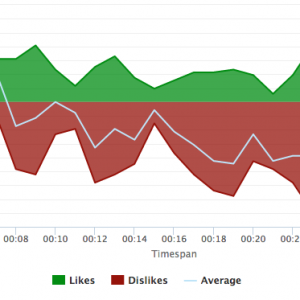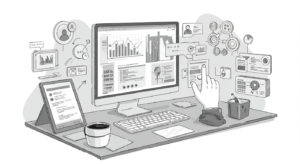How to Conduct Lean Market Research for Maximum Efficiency

Market research is an essential tool for businesses to attain maximum efficiency and profitability. However, conducting market research can often be an expensive and time-consuming process. As a result, many businesses are turning to lean market research to drive informed decision-making without breaking the bank. In this article, we will discuss how to conduct lean market research for maximum efficiency.
Understanding Lean Market Research
Before we dive into the strategies for conducting lean market research, let’s first define what lean market research is and its benefits compared to traditional market research methods.
What is Lean Market Research?
Lean market research is a method of conducting research that focuses on efficiency and cost-effectiveness. It involves gathering data from a sample of customers or potential customers through various methods, such as surveys or focus groups.
For instance, a business owner who wants to know the opinions of their customers about their products or services can use lean market research to gather data quickly and inexpensively. By using online surveys or social media polls, the business owner can get feedback from customers without spending a lot of money on traditional market research methods.
Benefits of Lean Market Research
One of the key benefits of lean market research is that it allows businesses to make informed decisions even with limited resources. It helps to identify the most critical aspects of a business problem without unnecessary expenses.
Moreover, lean market research can be conducted quickly, which means businesses can get insights and make decisions more rapidly. This is essential in today’s fast-paced business environment, where companies need to be agile and responsive to changes in the market.
Another advantage of lean market research is that it can be used to test new products or services before launching them. By gathering feedback from potential customers, businesses can make improvements to their offerings before investing significant resources in production and marketing.
Lean Market Research vs. Traditional Market Research
Traditional market research methods are typically more expensive and time-consuming than their lean counterparts. Traditional research methods may involve conducting extensive surveys or asking customers to participate in more lengthy focus groups.
On the other hand, lean market research focuses on minimal expenses and resources while still providing quality data and insights. This makes it an attractive option for small businesses or startups that may not have the budget for traditional market research methods.
Furthermore, lean market research can be more effective in certain situations, such as when a business needs to gather information quickly or test a new product or service. Traditional market research methods may take too long to provide insights, which could delay decision-making and hinder a business’s ability to respond to changes in the market.
In conclusion, lean market research is a valuable tool for businesses looking to gather insights quickly and cost-effectively. By using lean market research methods, businesses can make informed decisions even with limited resources, test new products or services before launching them, and respond more quickly to changes in the market.
Identifying Your Research Objectives
Before diving into conducting any research, it’s essential to define your research objectives. Identifying your research objectives will help you to gain clarity on what you want to achieve through your research efforts.
Research objectives can vary depending on the type of research you are conducting. Some common research objectives include:
- Gaining a better understanding of customer needs and preferences
- Identifying areas for improvement in products or services
- Assessing market opportunities and competition
- Evaluating the effectiveness of marketing campaigns
Once you have a clear understanding of your research objectives, you can begin to develop a plan for how to achieve them.
Defining Your Target Audience
Defining your target audience is a crucial step in conducting effective research. Your target audience is the group of people that you want to survey or interview in order to gather information.
Knowing who your audience is will help you identify the most effective way to reach them. For example, if your target audience is older adults, you may want to consider using a phone survey instead of an online survey.
Additionally, you can create a survey or interview guide tailored to their needs. Understanding your target audience’s interests, concerns, and preferences will help you to create questions that are relevant and meaningful to them.
Establishing Clear Goals and KPIs
Establishing clear goals and key performance indicators (KPIs) are vital to ensure your efforts align with your overall business strategy. Setting well-defined goals and KPIs will help in determining how you evaluate the success of the research.
For example, if your research objective is to assess market opportunities, your goal may be to identify at least three new market segments to target. Your KPIs may include the number of new market segments identified, the size of each segment, and the potential revenue each segment represents.
By establishing clear goals and KPIs, you can measure the success of your research and make data-driven decisions that align with your business strategy.
Prioritizing Research Questions
With a clear understanding of your target audience and research objectives, it’s time to determine which research questions to ask. The goal is not collecting every piece of information you can. Instead, it’s about identifying the most critical data points that will drive decision-making forward.
When prioritizing research questions, consider the following:
- What information is essential to achieving your research objectives?
- What questions will provide the most valuable insights?
- What questions are most likely to elicit honest and accurate responses from your target audience?
By prioritizing research questions, you can ensure that you are collecting the most relevant and valuable data to inform your business decisions.
Selecting the Right Research Methods
With your research objectives, target audience, goals and KPIs set, and research questions identified, it’s time to select your research methods. The following are commonly used research methods for lean market research.
Quantitative Research Methods
Quantitative research involves gathering numerical data that can be analyzed statistically. It includes online surveys, mobile surveys, and phone surveys. This method typically involves a large sample size and a high response rate.
Online surveys are a popular method of gathering quantitative data, as they can be easily distributed to a large number of people through email or social media. Mobile surveys, on the other hand, are becoming increasingly popular due to the widespread use of smartphones. Phone surveys are another option, although they can be more time-consuming and expensive.
When using quantitative research methods, it’s important to ensure that your sample size is representative of your target audience. This will help to ensure that your findings are accurate and reliable.
Qualitative Research Methods
Qualitative research involves gathering data about attitudes, opinions, and behaviors in-depth. This method includes in-depth interviews, online focus groups, and diary studies. Qualitative research typically involves a smaller sample size but allows for deeper insights into individual experiences and perceptions.
In-depth interviews are a common method of gathering qualitative data, as they allow researchers to delve deeper into a participant’s thoughts and feelings. Online focus groups are another option, and can be useful for gathering data from participants who are geographically dispersed. Diary studies involve participants keeping a diary of their experiences, and can provide valuable insights into their daily lives.
When using qualitative research methods, it’s important to ensure that your participants are representative of your target audience. This will help to ensure that your findings are relevant and useful.
Hybrid Research Methods
Hybrid research methods entail combining quantitative and qualitative research approaches to reduce the drawbacks of each method. Such an approach has the advantage of combining the strengths of both methods, while minimizing their weaknesses.
For example, a survey could be used to gather quantitative data, while in-depth interviews could be used to gather qualitative data. This would allow researchers to gain a deeper understanding of the data gathered through the survey, and to explore any interesting or unexpected findings in more detail.
When using hybrid research methods, it’s important to ensure that the different methods used are complementary and that the data gathered is integrated effectively. This will help to ensure that your findings are comprehensive and robust.
Designing Lean Surveys and Questionnaires
Market research is a vital aspect of any business, but it can be costly and time-consuming. However, with the right research methods, you can gain valuable insights from your target audience while keeping costs minimal. Once you have selected your research methods, it’s time to design your survey or questionnaire.
Crafting Effective Questions
The key to creating an effective survey or questionnaire is to craft clear and concise questions. Your questions should be easy to understand, and you should avoid using jargon or complicated language. Using the appropriate question type for each situation is also important. Closed-ended questions, for example, are useful when you want to collect quantitative data, while open-ended questions are better for collecting qualitative data.
It’s also important to consider the order of your questions. Start with simple and straightforward questions to engage your audience and build their confidence. As you progress, you can ask more complex questions that require more thought and consideration.
Ensuring Survey Brevity
One of the most important things to consider when designing your survey or questionnaire is brevity. To guarantee an optimal response rate, ensure that your questionnaire is short and straightforward. Provide only necessary questions that directly correspond to the research objectives to decrease the chances of survey fatigue.
One way to ensure brevity is to use skip logic. Skip logic allows you to show or hide questions based on the respondent’s previous answers. This technique can help you to keep your survey short while still collecting all the necessary data.
Utilizing Online Survey Tools
Using online survey tools play a crucial role in the lean market research process. Online survey tools such as Spot Trender save time and money on survey administration and are cost-effective. These tools can help you to create and distribute your survey quickly and easily.
Online survey tools also offer several features that can help you to analyze and visualize your data. For example, you can create charts and graphs that make it easy to understand and communicate your findings. Some tools also offer advanced data analysis features, such as cross-tabulation and regression analysis, that can help you to identify patterns and relationships in your data.
In conclusion, designing lean surveys and questionnaires requires careful consideration of several factors, including question clarity, brevity, and the use of online survey tools. By following these tips, you can create effective surveys that provide valuable insights into your target audience while keeping costs minimal.
Conclusion
Lean market research enables businesses to make informed decisions without breaking the bank. By understanding your research objectives, defining your target audience, setting clear goals and KPIs, prioritizing research questions, selecting the right research methods, and designing effective surveys and questionnaires, you can ensure the most effective and efficient research effort. Remember to use online survey tools to save time and money while creating easy-to-use surveys or questionnaires. Maximizing your market research effectiveness has never been more achievable through modern research tools and practical lean research principles.







